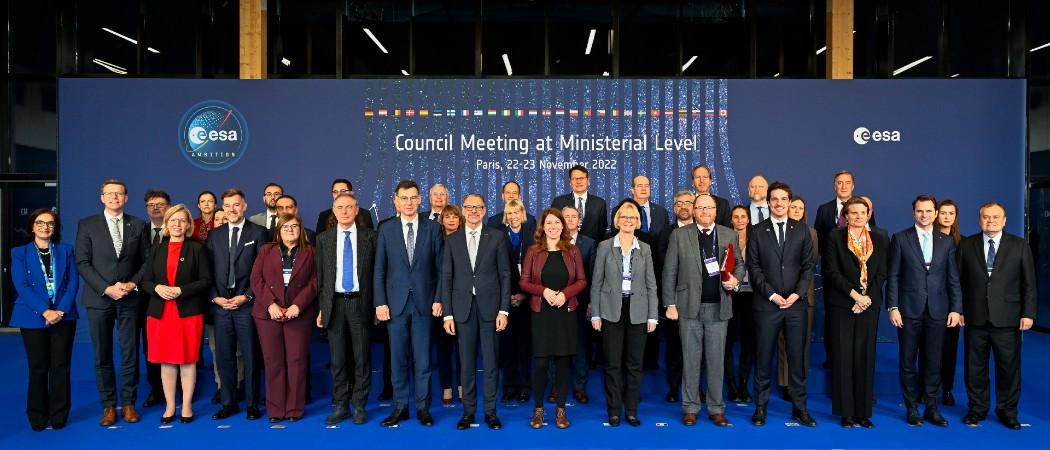In times of tight finances, ESA funding for the next three years is going up by 17%, but the US and China are investing significantly more in their space programmes

The European Space Agency (ESA) council of ministers meeting took place in Paris this week. Photo: ESA - S. Corvaja
The European Space Agency (ESA) ministerial council agreed to increase the agency’s budget to €16.9 billion over the next five years, in a bid to improve Europe’s position in the space race, but it still has a long way to go before catching up with China and the US.
"This budget is a positive result, which will keep Europe in the space race, [. . .] but the increased contribution to the programmes doesn't put us on the same level as China or the US," whose budget is six or seven times that of ESA, said Eurospace secretary general Olivier Lemaitre.
The ministerial council meeting in Paris this week set out ambitions to catch up with the US space agency NASA and China’s National Space Administration. Over the past months, both ESA and the EU have been calling for European countries to raise their game in space, saying it is a critical domain for European autonomy and resilience, science and industrial competitiveness.
The agreed budget is a compromise between the ESA's proposed €18.5 billion and a minimum of €16.5 billion. Germany, France and Italy remain the top contributors, paying €3.5 billion €3.2 billion and €3.8 billion, respectively. The UK will invest £1.84 billion.
The scientific programmes will get the biggest slice of the cake, with some €3.1 billion(19%), followed by space transportation with €2.8 billion (17%) and €2.7 billion for human and robotic exploration (16%).
Lemaitre saw it as a positive sign that nearly all programmes will get sufficient funding and that the money overall increased. Likewise, it is positive that the increased contribution was not only provided by Italy, France and Germany, but also by Belgium, Spain and the Netherlands. “[This] shows that space in Europe is taken more and more seriously by more and more countries, and that's very clearly a positive result regarding the evolution of the institutional project,” Lemaitre said.
Unlike in other institutions, the ESA budget is based on a bottom-up approach, meaning that the resulting budget is the sum of member states' contributions based on what they want to achieve in space.
But despite the increased budget, Lemaitre noted that the gap with the US, where NASA plans to spend €24 billion in 2023 alone, and China, where the level of activity is very high, though the budget is secret) remains.
Lack of coordination
Lemaitre said a further problem is that Europe's spending also includes national expenditure.
Green MEP Niklas Nienaß, shadow rapporteur for the European Parliament's file on the new telecommunications satellites IRIS², drafted by the committee on Committee on Industry, Research and Energy, ITRE, said, "We are far away from the $24 billion of the US.” To improve the situation, he suggested money should be spent wisely and Europe should find a way to generate additional investment from private sources, to provide more value to the space sector.
Among the funded programmes, ESA increased the budget for the rockets Ariane 6 and Vega C, which are considered a key asset, since launching capabilities are prerequisites of activities such as deploying satellite constellations.
The first flight of Ariane 6 was originally scheduled for 2020, but it has now been pushed to the end of 2023. Vega-C, a smaller rocket, had its inaugural launch in July.
This was a positive sign, as ESA missions currently rely on Elon Musk’s SpaceX launchers after the agency broke ties with Russia over its invasion of Ukraine, and lost access to its Soyuz rockets.
On 22 November, France, Germany and Italy signed an agreement to guarantee the future of Ariane 6 and VEGA-C.
Josef Aschbacher, ESA director general, said the increased budget for Ariane 6 is a "very important milestone” as he was not sure that Europe would have been united on the project.
The meeting also resulted in good news for the Rosalind Franklin Mars rover, part of the beleaguered €1.3 billion ExoMars programme, which is to receive €360 million and should now launch in 2028.
The programme has the scientific goal of investigating the existence of past or present life on Mars and exploring the surface of the planet, acquire samples and analyse them.
"I'm very glad [. . .] that Europe will take responsibility for the majority of this ExoMars mission, and that will be done with European technology," said Aschbacher, adding that the US might be willing to join the project.
On IRIS2, the new programme for telecommunications satellites, ESA approved €642 million in contributions instead of the expected €750 million. The €2.4 billion satellite network aims to provide secure and encrypted communications for government and military users in Europe, and to plug holes in internet access in Africa. It received the green light from EU institutions on 17 November.





 A unique international forum for public research organisations and companies to connect their external engagement with strategic interests around their R&D system.
A unique international forum for public research organisations and companies to connect their external engagement with strategic interests around their R&D system.